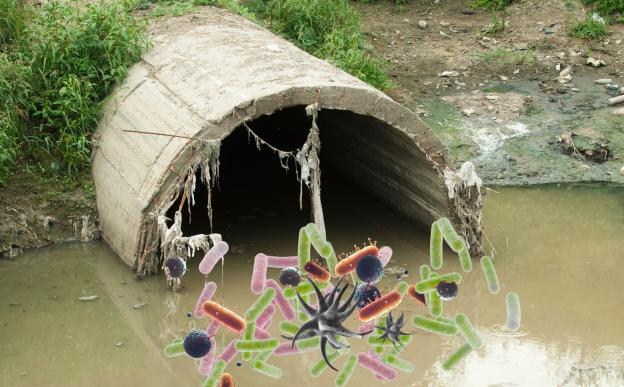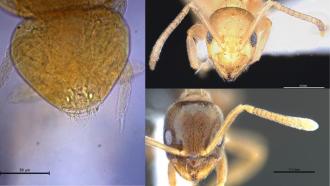![Lilac Silverline (Apharitis lilacinus) [Image Credits: Krushnamegh Kunte] Understanding the basis of the amazing association between butterflies and ants](/sites/researchmatters/files/styles/large_800w_scale/public/butterfly_14jul.jpg?itok=qZ1QoVsH)
Lilac Silverline (Apharitis lilacinus) [Image Credits: Krushnamegh Kunte]
For what would a butterfly depend on ants? At face value, it may seem like not much. However, caterpillars of butterflies that belong to the family Lycaenidae, have an unlikely relationship with ants—they rely on ants for protection from predators. These butterflies are also called gossamer-winged butterflies because of their delicate, often iridescent wings. Amazingly, the ants they associate with do not eat the caterpillars. Instead, they guard the larvae and create a safe space for them to grow, moult and reach adulthood. This unique association is called myrmecophily (literally, 'ant-love'). Of course, the caterpillars have also evolved many morphological and behavioural features to make sure this association lasts.
Although myrmecophily in lycaenid caterpillars is well documented, researchers at the National Centre for Biological Sciences (NCBS), Bengaluru, have used a new technique to understand the mechanisms that sustain this relationship. A recent study conducted by Dipendra Nath Basu, a PhD scholar and his advisor, Dr Krushnamegh Kunte, used X-ray microtomography to look at the organs and body structure of the caterpillars and how they relate to different functions. X-ray microtomography, or microCT for short, produces 3D projections of an object using X-rays, similar to the CT scan used by doctors for diagnosis. The study, published in the journal Scientific Reports, was funded by the Department of Science and Technology (DST), Department of Atomic Energy (DAE) and the Council for Scientific and Industrial Research (CSIR).
"MicroCT has recently emerged as a valuable tool for studying organ development and functional morphology of smaller animals, such as lizards and insects", says Dipendra. "Using MicroCT, we can map the entire internal structure of the body in great detail, without the need to dissect and disrupt the organs. With a single scan, any structure inside the body can be studied either in isolation or with other structures," he adds.
The researchers used MicroCT to study the functional morphology of Lilac Silverline caterpillars (Apharitis lilacinus) and their associations with the cocktail ant (Crematogaster hodgsoni). The female butterflies lay eggs on sandy areas near the ant nests, and from then on, are reared entirely by the ants as the caterpillars rely on the regurgitated food from the ants for nutrition, besides protection.

Ants tending to a Lilac Silverline caterpillar [Image Credits: Krushnamegh Kunte]
But what could the caterpillars have that draws the ants to care for them? The researchers looked in detail at three specialised caterpillar organs— the dew patches, nectar glands, and the tactile organs. Together, these three organs, along with the pore cupola, effectively tame the ants into becoming caterpillar caregivers. The pore cupola glands, which have been characterised in earlier studies, are located on the caterpillar's body surface and secrete pheromones that not only make them recognisable to ants but also subdue their aggressive behaviour. A pair of dew patches produce carbohydrate-rich, sugary secretions which serve as a reward for the ants, ensuring that they continue to tend to the caterpillars. The nectar glands also produce these sugary secretions.
“In some species, the secretions of dew patches and nectar glands alter the levels of neurotransmitters, particularly dopamine, in the brains of their attendant ants,” adds Prof. Naomi Pierce of Harvard University, a leading expert on caterpillar-ant associations. “This change causes them to slow their locomotory activity. It also makes the ants more faithful to the caterpillars and increases the level of aggression toward their parasites and predators.” Besides, these caterpillars have specialised tactile organs that they can evert to sense where they should move, or deter ants from tending.
The researchers noticed a 'push and pull' mechanism between ants and caterpillars. The caterpillars, through synergistic contraction and relaxation of the muscles around the dew patches, released the sugars (also called honeydew secretions) that lured the ants.
“Caterpillars can sometimes even deceive the ants by luring them with these secretions, but then reabsorbing the secretions before ants can take them,” adds Dipendra. “One supposes that the caterpillars have to juggle between keeping the tending ants happy so that they continue to receive protection while minimizing the energetic cost of producing these nutritious secretions.”
Further, they found tiny tufts of hair, called cilia, in the tactile organs. These structures could be turned inside out when too many ants swarmed a particular region of the caterpillar. Interestingly, the researchers also found a thick tissue lining the caterpillar body to protect itself against the possibility of ant aggression. The foregut also had a tiny volume compared to other caterpillar species. It could be because Lilac Silverlines rely on regurgitated food from ants, rather than tough vegetation like other caterpillar species.
Mechanistic studies, like the current one, are integral to better understanding behavioural and ecological aspects of caterpillar adaptations.
"This work opens up the wonderful world of caterpillar-ant associations for Indian biologists and naturalists", remarks Prof. Naomi Pierce on the study. "It is important to study not only the diversity of caterpillar structures and behaviours but also their species-specific associations with ants that might have evolved over millions of years across India's biodiversity hotspots."
This article has been run past the researchers, whose work is covered, to ensure accuracy.

























